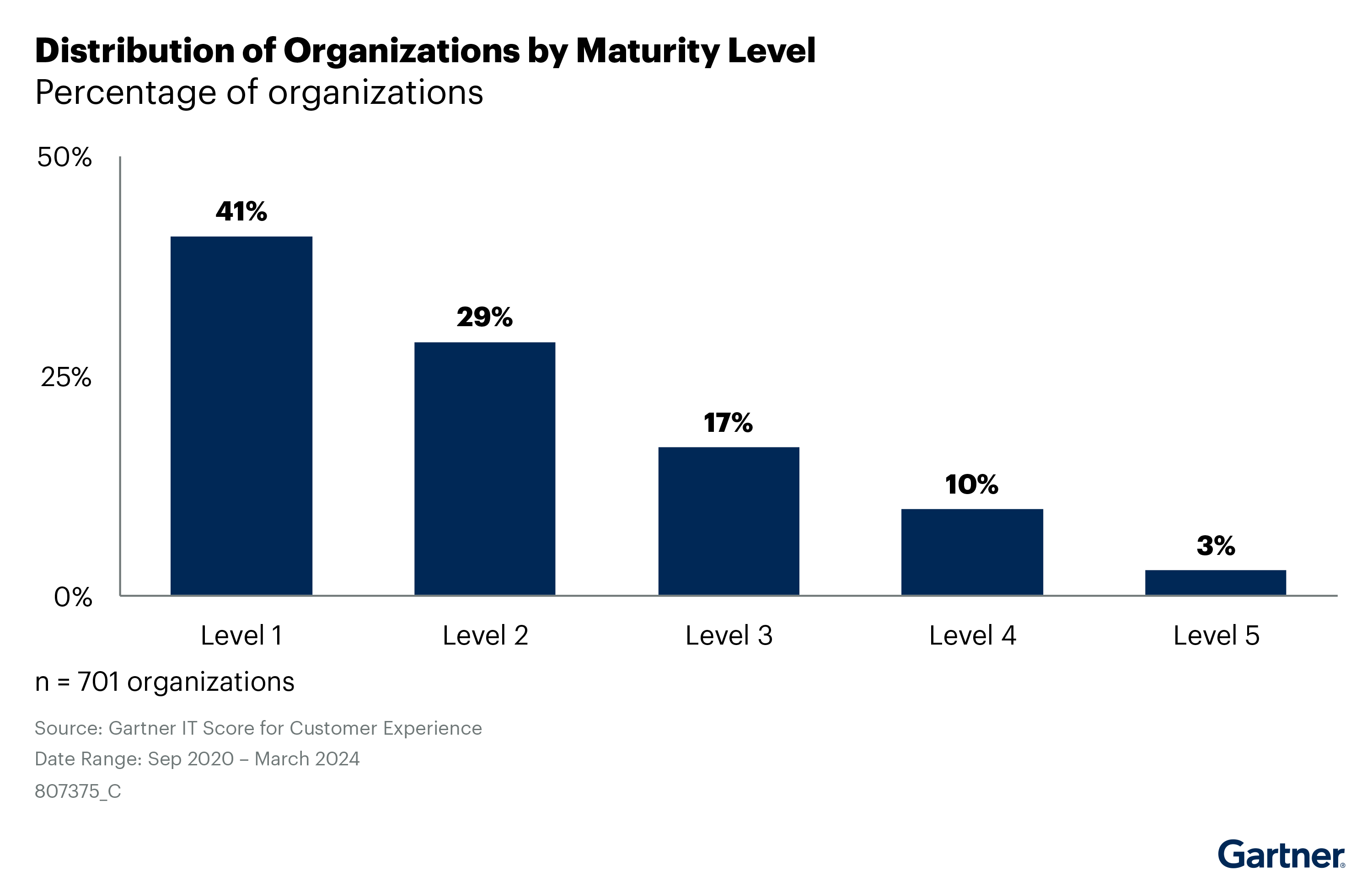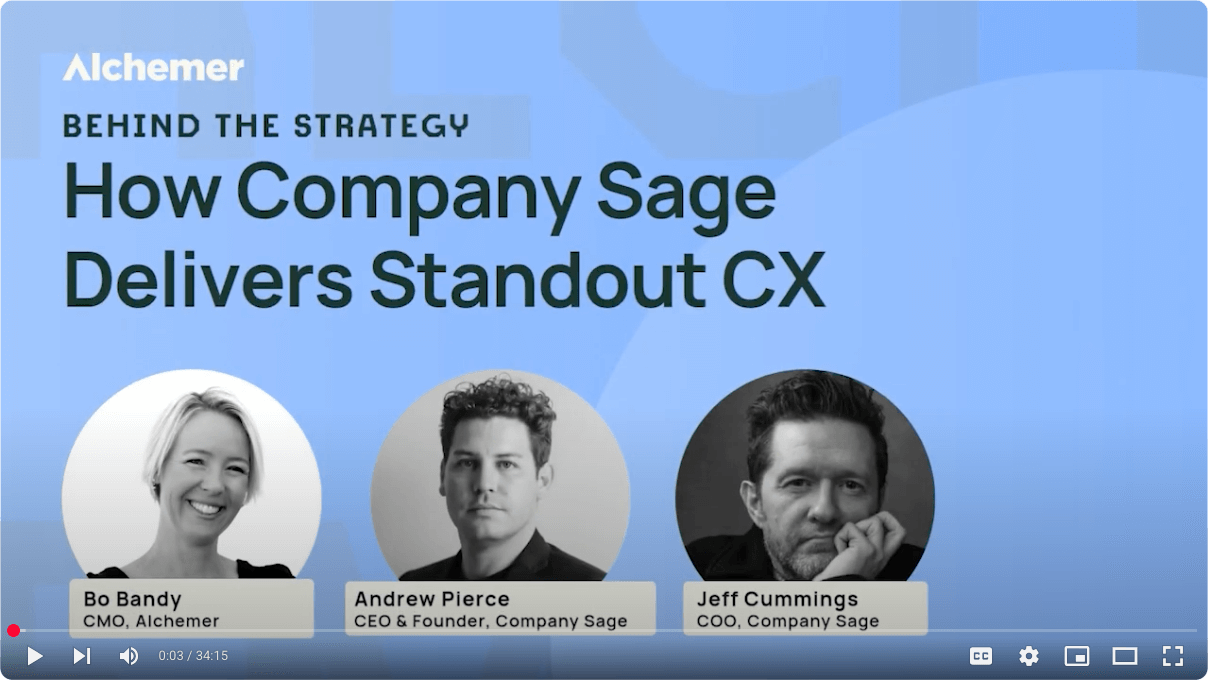In today’s market, CX is a powerful differentiator—it has the potential to transform customer relationships, drive long-term growth, and set organizations apart from their competitors. As organizations advance in CX maturity, they move from ad hoc processes to a more strategic approach. This evolution involves adopting a data-driven strategy that creates consistent, personalized experiences. This maturity fosters deeper customer loyalty, enhanced satisfaction, and higher retention rates.
We feel the Gartner CX Maturity Model1 helps organizations assess their current state and provides a clear roadmap for improvement. The Gartner model outlines the stages companies typically go through as they enhance their CX capabilities. It also provides the steps needed to improve or evolve your approach to CX.
Understanding CX maturity: What does it really mean?
Customer experience (CX) maturity reflects how effectively an organization designs, manages, and continuously improves its customer interactions across every touchpoint. This maturation allows businesses to create more personalized and consistent interactions with customers. As a result, they foster more meaningful connections, which lead to sustained growth.
We believe the Gartner CX Maturity Model helps organizations assess where they currently stand and what they need to do to advance in maturity. The model outlines stages that organizations typically progress through as they develop a more sophisticated approach to CX. It covers key aspects such as customer understanding, CX strategy, and cross-departmental coordination.
Gartner model: The five levels of CX maturity
Level 1: Ad Hoc
At this initial stage, departments or divisions typically silo their CX efforts, resulting in fragmentation. There is little coordination or collaboration across the organization, and CX initiatives lack consistency or a strategic approach. As a result, many efforts to improve CX are reactive and not yet aligned with broader organizational goals.
Level 2: Establishing
Organizations at this level begin to recognize the importance of CX and designate a CX leader or team to drive efforts. The focus shifts to identifying CX capability gaps, establishing processes, and understanding the key drivers of customer dissatisfaction. At times, teams still silo their efforts. However, they are increasingly recognizing that improving CX can address pain points and foster customer loyalty.
Level 3: Performing
At this stage, organizations have successfully demonstrated how improvements in customer satisfaction directly contribute to achieving business and financial goals. The organization has well-defined and integrated CX processes. Teams consistently implement customer feedback loops, performance metrics, and strategic initiatives, making CX a key driver of business success.
Level 4. Optimizing
Organizations at the “Optimizing” level have achieved a high degree of alignment and maturity in their CX efforts. There is a shared, organization-wide understanding of customer needs and expectations. CX is embedded in the company’s operations and is no longer the responsibility of just one team. Dedicated CX groups or councils regularly review performance and drive continuous improvements.
Level 5. Embedded
At the highest level of CX maturity, the organization fully integrates customer-centricity into its culture. Every employee, from frontline workers to executives, understands the importance of delivering excellent customer experiences and is empowered to make decisions that align with customer needs. CX is a core part of the company’s DNA, influencing strategy, innovation, and day-to-day operations. The organization deeply embeds the customer’s voice in decision-making processes at every level.
Assessing the landscape: How mature are most organizations?

This graphic was published by Gartner, Inc. as part of a larger research document and should be evaluated in the context of the entire document.
In the Gartner report, they found that 41% of organizations fall into level one, with a drop-off at every subsequent level. To us, this indicates that many companies are still in the early stages of developing a customer-centric approach. As organizations progress toward higher levels of CX maturity, the numbers drop sharply, with only 10% reaching Level 4 (Optimizing) and just 3% achieving the highest level, Level 5 (Embedded).
We believe this data underscores the fact that most organizations still have considerable work to do in building a more mature and cohesive CX strategy. However, we feel it also highlights a significant opportunity: organizations at earlier stages can take proactive steps to establish foundational practices early in their CX journey.
By aligning leadership, defining clear CX goals, and implementing robust processes early on, these organizations can set themselves up for long-term success.
The path to CX maturity is not an easy one, but the benefits of advancing through these stages are undeniable. From increased customer loyalty to boosted financial performance, and an enhanced competitive edge, organizations that prioritize CX are positioning themselves as leaders in their industry.
Continue Reading
You can continue reading and access the Gartner full model and report on the Gartner website. In the report you will find:
- An overview of the three pillars of and nine critical capabilities that define CX maturity
- Deep dives into the characteristics of each CX maturity level along with actionable steps to reach the next level.
- Additional Gartner research and insights on CX maturity.
Ultimately, the organizations that prioritize CX and invest in its ongoing evolution will be the ones that thrive, build deeper customer relationships, and stay ahead of the curve in the future. Use the Gartner model to assess where you are now—and where you can go next—on your journey toward CX excellence.
Ready to continue your CX journey? CX programs thrive on customer feedback. Learn how to create an omnichannel feedback program to develop CX insights that will drive your business forward.
1: Source: Gartner, Use Gartner’s Maturity Model to Evolve Your Customer Experience, Michael Chiu, Don Scheibenreif, et al, 10 May 2024.
GARTNER is a registered trademark and service mark of Gartner, Inc. and/or its affiliates in the U.S. and internationally and is used herein with permission. All rights reserved.




